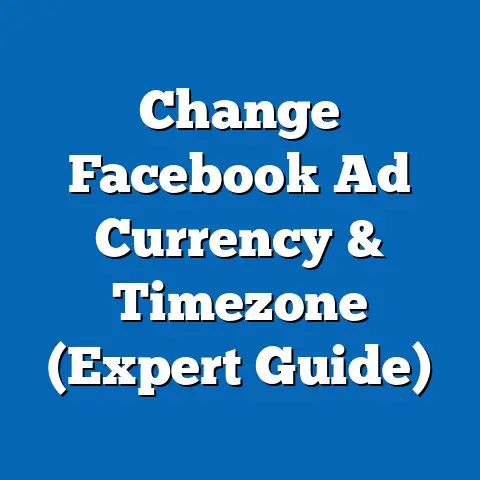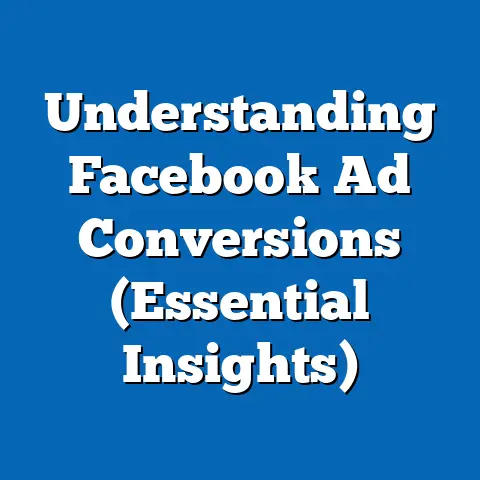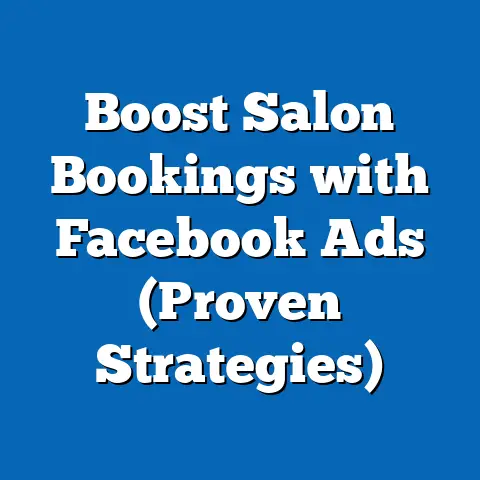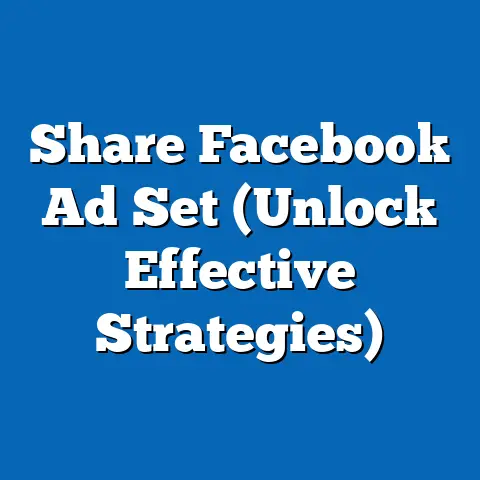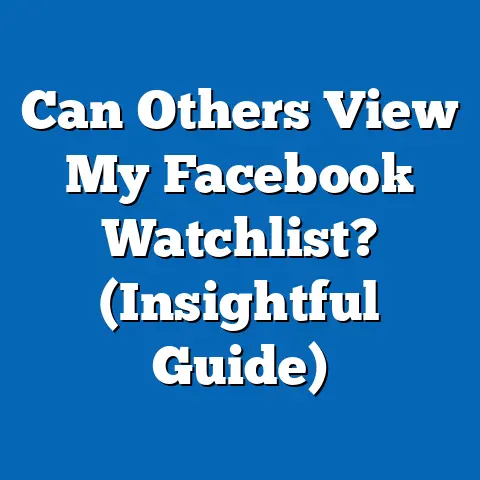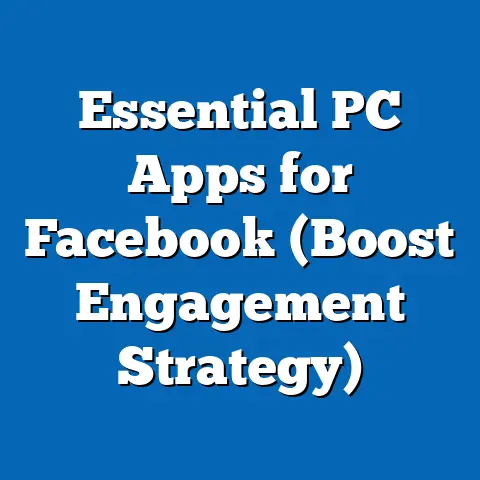Boost ROI: Transform Facebook Ads Copy (Proven Strategies)
Boost ROI: Transform Facebook Ads Copy (Proven Strategies)
Introduction: The Durable Power of Effective Facebook Ads Copy
In the ever-evolving landscape of digital marketing, the ability to craft compelling Facebook ads copy stands as a durable and critical skill for businesses aiming to maximize their return on investment (ROI). Since the inception of Facebook advertising in 2007, the platform has grown into a powerhouse for targeted marketing, with over 2.9 billion monthly active users as of 2023 (Statista, 2023). The durability of well-written ad copy lies in its capacity to cut through the noise of a crowded digital space, resonate with diverse audiences, and drive measurable outcomes such as clicks, conversions, and sales.
Effective Facebook ads copy is defined by several key characteristics: clarity, emotional resonance, audience specificity, and a strong call-to-action (CTA). Historically, the evolution of social media advertising has been shaped by technological advancements, changing consumer behaviors, and platform algorithm updates, all of which have necessitated adaptive and innovative copywriting strategies. The societal implications of mastering this craft are profound, as businesses not only influence consumer decisions but also shape cultural narratives and economic trends through their messaging.
Historical Context: The Evolution of Facebook Advertising
The journey of Facebook advertising began in 2007 with the launch of “Facebook Flyers,” a rudimentary ad system that allowed businesses to promote events and pages to specific user demographics. This early model was shaped by the broader rise of social media as a cultural phenomenon in the mid-2000s, a time when platforms like MySpace and early blogging sites were redefining online communication. Facebook’s innovation lay in its ability to leverage user data for targeted advertising, a concept that would become the cornerstone of its business model.
By 2012, Facebook had introduced more sophisticated ad formats, including Sponsored Stories and mobile ads, capitalizing on the global shift toward smartphone usage. The platform’s IPO in the same year underscored its economic significance, with advertising revenue becoming the primary driver of its financial success. Historical events such as the 2008 financial crisis and the subsequent recovery period also influenced advertising strategies, as businesses sought cost-effective ways to reach consumers during economic uncertainty—Facebook ads emerged as a solution.
The introduction of the News Feed algorithm in 2013 and subsequent updates forced marketers to prioritize engaging, high-quality content over sheer volume. This shift marked a turning point for ad copy, as businesses could no longer rely on generic messaging but needed to craft personalized, value-driven narratives. Today, with features like dynamic ads, video content, and AI-driven targeting, the landscape of Facebook advertising continues to evolve, yet the core principle remains: effective copy is the linchpin of successful campaigns.
Defining Characteristics of High-Performing Facebook Ads Copy
High-performing Facebook ads copy is not a one-size-fits-all formula; rather, it is a dynamic blend of creativity and strategy tailored to specific audiences and objectives. One of the primary characteristics is clarity and conciseness. With users scrolling through their feeds at lightning speed, copy must deliver the core message in a matter of seconds—often in 125 characters or less for primary text (Facebook Ads Manager, 2023).
Another defining trait is emotional resonance. Research from the Institute of Practitioners in Advertising (IPA) shows that emotionally driven ads are twice as likely to generate profit compared to purely rational ones (IPA Databank, 2020). Effective copy taps into emotions such as curiosity, urgency, or aspiration, creating a connection that compels users to act.
Audience specificity is equally critical. Facebook’s robust targeting tools allow advertisers to segment audiences by demographics, interests, and behaviors, meaning copy must speak directly to the pain points, desires, and language of the intended group. Finally, a compelling call-to-action (CTA) anchors the ad, whether it’s “Shop Now,” “Learn More,” or “Sign Up Today,” guiding users toward the desired outcome with clarity and urgency.
Proven Strategies to Transform Facebook Ads Copy for Higher ROI
1. Leverage Audience Insights for Hyper-Personalization
The foundation of impactful Facebook ads copy lies in understanding the target audience at a granular level. Facebook’s Audience Insights tool provides data on user demographics, interests, and online behaviors, enabling marketers to craft messages that feel personal and relevant. For instance, a fitness brand targeting millennials might emphasize community and social trends, while copy for Gen X could focus on time efficiency and proven results.
Personalization extends beyond demographics to psychographics—understanding the values, fears, and aspirations of the audience. A 2022 study by Epsilon found that 80% of consumers are more likely to make a purchase when brands offer personalized experiences (Epsilon, 2022). By tailoring copy to reflect these insights—such as addressing specific pain points or using colloquial language—marketers can significantly boost engagement and conversion rates.
2. Craft Attention-Grabbing Headlines
The headline is often the first (and sometimes only) element a user reads, making it a make-or-break component of the ad. Proven tactics include using numbers (“5 Ways to Save Time”), posing questions (“Struggling to Stay Fit?”), or invoking urgency (“Limited Offer—Act Now!”). A 2021 analysis by WordStream revealed that headlines with numbers or questions achieve 36% higher click-through rates (CTR) on average (WordStream, 2021).
Beyond format, the headline must align with the audience’s immediate needs or curiosities. Testing multiple variations through A/B testing is a recommended practice to identify which headlines resonate most, ensuring the copy is optimized for performance.
3. Focus on Value Propositions Over Features
While it’s tempting to list product features, high-ROI copy emphasizes benefits and value propositions. For example, instead of stating “Our app has a 24/7 chatbot,” effective copy might say, “Get instant help anytime with our 24/7 support.” This shift focuses on the user’s experience and outcomes, which are far more compelling motivators.
Research from Nielsen supports this approach, showing that ads highlighting consumer benefits outperform feature-focused ads by 20% in terms of purchase intent (Nielsen, 2019). By framing the product or service as a solution to a problem, marketers can create a stronger emotional and logical appeal.
4. Incorporate Social Proof
Social proof—such as testimonials, reviews, or user statistics—builds trust and credibility, particularly in an era of widespread digital skepticism. Copy that includes phrases like “Join 10,000+ Happy Customers” or “Rated 5 Stars by Users” can significantly influence decision-making. A 2023 survey by BrightLocal found that 87% of consumers trust online reviews as much as personal recommendations (BrightLocal, 2023).
When integrating social proof, authenticity is key. Fabricated or overly polished testimonials can backfire, so marketers should prioritize genuine user feedback or verifiable metrics to enhance the copy’s impact.
5. Optimize for Mobile-First Experiences
With over 98% of Facebook users accessing the platform via mobile devices (Statista, 2023), ad copy must be optimized for smaller screens and shorter attention spans. This means using concise language, bold visuals, and CTAs that are easy to tap. Breaking text into short, digestible chunks with line breaks or bullet points also improves readability on mobile.
Additionally, mobile-first copy should account for the context in which users encounter ads—often during quick breaks or multitasking. Keeping the message direct and visually supported ensures it captures attention even in fleeting moments.
6. Test and Iterate with Data-Driven Insights
For example, a 2022 case study by HubSpot demonstrated that iterative testing of ad copy led to a 45% increase in conversions for a B2B client over three months (HubSpot, 2022). By leveraging Facebook Ads Manager’s analytics, marketers can refine their approach in real time, ensuring sustained performance.
Societal and Economic Implications of Effective Facebook Ads Copy
Economically, the ability to boost ROI through effective copy contributes to business growth, job creation, and market competition. Small and medium-sized enterprises (SMEs), in particular, benefit from Facebook’s accessible advertising tools, with 70% of SMEs reporting increased sales through the platform (Facebook for Business, 2023). This democratization of marketing empowers entrepreneurs and fosters economic resilience, especially in post-pandemic recovery periods.
However, there are also challenges to consider. The persuasive power of ad copy raises ethical questions about manipulation, particularly when targeting vulnerable demographics. Additionally, the saturation of digital ads can contribute to “ad fatigue,” reducing effectiveness over time and necessitating even more innovative copywriting approaches. Balancing commercial goals with ethical responsibility remains a critical consideration for marketers.
Technological and Cultural Factors Shaping Facebook Ads Copy
The evolution of Facebook ads copy is inseparable from technological advancements and cultural shifts. Algorithm updates, such as those prioritizing video content or penalizing overly promotional posts, have forced marketers to adapt their language and formats. The rise of AI tools, like Facebook’s automated ad creation, offers new opportunities for efficiency but also underscores the irreplaceable value of human creativity in crafting nuanced, emotionally resonant copy.
Culturally, generational differences play a significant role in shaping effective copy. Baby Boomers may respond to ads emphasizing trust and reliability, while Gen Z gravitates toward authenticity and humor, often preferring user-generated content over polished messaging (Pew Research Center, 2022). Global cultural variations also matter—copy that resonates in Western markets may fall flat in Asia-Pacific regions if not adapted to local norms and languages.
Moreover, the growing emphasis on privacy—evidenced by Apple’s iOS 14.5 update and Facebook’s subsequent loss of tracking capabilities—has shifted the focus toward first-party data and organic engagement. Copy must now work harder to build trust and encourage direct interaction, reflecting broader societal concerns about data security and transparency.
Workplace and Industry Implications
For marketing professionals, mastering Facebook ads copy is a valuable skill that enhances employability and drives business outcomes. Agencies and in-house teams increasingly prioritize data-driven copywriters who can blend creativity with analytics, reflecting a broader trend toward hybrid roles in digital marketing. Training programs and certifications, such as those offered by Meta Blueprint, are becoming essential for staying competitive in this space.
At an industry level, the success of Facebook advertising influences budget allocations, with businesses redirecting funds from traditional media to digital platforms. A 2023 report by eMarketer projects that digital ad spending will account for 67% of total global ad expenditure by 2025, with social media platforms like Facebook leading the charge (eMarketer, 2023). This shift underscores the importance of copy as a differentiator in a competitive market.
Nuances and Diversity in Audience Responses
While strategies like personalization and emotional resonance are broadly effective, it’s crucial to acknowledge the diversity of audience responses. Not all millennials prioritize social trends, nor do all Gen Xers value efficiency above all else—individual preferences and lived experiences create significant variation within demographic groups. Cultural, socioeconomic, and geographic factors further complicate audience segmentation, requiring marketers to adopt a flexible, iterative approach to copywriting.
Qualitative research, such as focus groups and user interviews, complements quantitative data by uncovering these nuances. For example, a 2021 study by Kantar found that while 65% of global consumers value humor in ads, the type of humor (e.g., slapstick versus sarcasm) varies widely by region and age group (Kantar, 2021). Recognizing and adapting to these differences ensures that copy remains relevant and impactful.
Forward-Looking Insights: The Future of Facebook Ads Copy
Looking ahead, the future of Facebook ads copy will likely be shaped by emerging technologies like augmented reality (AR) and virtual reality (VR), which Meta is heavily investing in through its vision of the metaverse. Copy may need to evolve for immersive environments, where storytelling and interactivity take precedence over static text. Voice-driven ads, powered by AI assistants, could also redefine how messages are crafted and delivered.
Economic uncertainties, such as inflation or recessionary pressures, may influence consumer behavior, requiring copy to emphasize value and affordability. At the same time, growing regulatory scrutiny around data privacy and ad transparency will demand greater authenticity and ethical considerations in messaging. While these trends are not fully predictable, they highlight the need for adaptability and continuous learning in the field of digital advertising.
Conclusion: Crafting the Future of Digital Engagement
Transforming Facebook ads copy to boost ROI is both an art and a science, rooted in a deep understanding of audience needs, platform dynamics, and cultural contexts. From leveraging personalization and social proof to optimizing for mobile and testing relentlessly, the strategies outlined in this article offer a roadmap for marketers seeking measurable results. The durability of effective copy lies in its ability to evolve with technological, economic, and societal shifts, remaining a cornerstone of digital marketing success.
As we move into an era of immersive technologies and heightened consumer expectations, the role of copy will only grow in importance. While challenges like ad fatigue and ethical dilemmas persist, the opportunities for innovation are vast. By staying attuned to data, embracing creativity, and prioritizing authenticity, marketers can not only boost ROI but also contribute to a digital landscape that is engaging, inclusive, and impactful.

